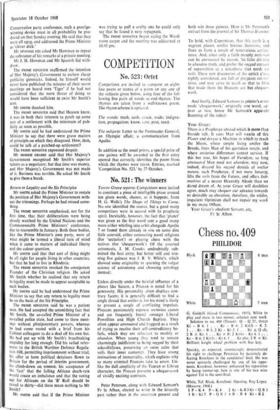Chess no. 409
PHILIDOR
Black White 7 men 6 men
G. Guidel i (Good Companions, 1915). White to play and mate in two moves; solution next week. Solution to no. 408 (Tuxen): Q - Q 2!, threat Kt - B 4. 1 . . . Kt - B 6; 2 Kt(3) - K 5.
1 . .. Kt - B 3; 2 Kt - Kt 2. 1 ...Kt K. Q ch;
2 R x Kt. 1 . . . Kt x P; 2 Kt(6) - Kt 4. 1 ... Kt - B 4; 2 Kt(3) - Kt 4. I . . Kt else; 2 R x Kt. Brilliant knight wheel problem with fine key.
Spassky, as expected, convincingly demonstrated his right to challenge Petrosian by decisively de- feating Korchnoi in the candidates' final. He was never seriously challenged by any of his oppo- nents. Korchnoi. however, enhanced his reputation by being runner-up; here is one of his two wins against Tal in the semi-final.
White, Tal. Black, Korchnoi. Opening, Ruy Lopez. (Moscow, 1968.) 1 P-K 4 P-K4 2 Kt-KB3Kt-QB 3 3 B-Kt 5 P-QR 3 4 B - R 4 Kt-B 3
5 0 – 0 B–K2 6 R–K 1 P–QKt 4
7 B–Kt 3 P–Q 3 8 P–B3 0-0
9 P–KR 3Kt–QR4 10 B–B 2 P–B4 11 P–Q4 Q–B2 12 QKt–Q2Kt--B 3
13 PXBP The alternative is 13 Kt – B 1 and 14 P – Q 5; Tal probably prefers the slightly more open position after the pawn exchange.
13 . . . PxP 14 Kt–BI B–K 3 15 Kt – K3 QR–Q 1 16 Q–K 2 P–B5 17 Kt – B 5 . . . 17 Kt – Kt 5 can be met by 17 . . . Kt – Q 5!
17 . . . BxKt 18 PxB KR–K 1 19 B – Kt 5 P – K R 3 20 B x Kt . . . The strength in White's position lies in the K4 square—he therefore exchanges of the knight which controls it; it is interesting to see how Black counters this manoeuvre.
20 . . . B x B 21 Kt – Q 2 Kt – K 2!
22 Kt – K 4 Kt – Q 4 23 P–QKt3 . . .
A risky attempt to win (he was one game behind in the match); if he plays instead P K Kt 3 (to stop Kt – B 5 Q 6) Black will play B – K 2 and Kt – B 3 with a com- fortable game.
23 . . . Kt X P! A move that White, of course, had seen but may have underestimated.
24 KtXBchPXKt 25 Q–K 3 PXP 26 BXP K–R 2 27 KR–QB 1? ... Too ambitious. He should regain his pawn by
27 B X P, Q X B; 28 Q X Kt with chances for both sides. Now Korchnoi plays a very fine counter-attack.
27 . . . P – Kt 5 28 P – R 3 P – K 5! Tal must have overlooked this.
29 P xP . R–Q 6 30 Q–K 1 P–K6! 31 B–B2 R–Q 7! 32 P X P Kt–K 7ch 33 K – R I Kt–Kt 6 ch34 K – Kt 1 . . .
34 K – R 2, Kt – B 8 db ch; 35 K – Kt 1, Q – R 7 6.11; 36K X Kt, Q – R 8 mate.
34 . . . R – K 7 35 Q – Q 1 Q – Kt 2 36 P – K 4 R(1)x KM 37 Resigns . . . '
37 B X R, Q X B and mates or 37 B – Q 3, R x P ch; 38 K X R, R – K 7 d. ch; 39 K X Kt, Q – Kt 7 ch; 40 K – B 4, Q – Kt 4 ch; 41 K – B 3, Q – K 6 ch; 42 K – Kt 4, R – Kt 7 ch; and 43 . . . Q –Kt 4 mine.







































 Previous page
Previous page